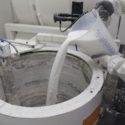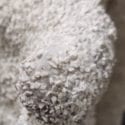Ludox Key to Flotation Extraction

Human impact on the planet is a constant concern, and scientists all over the globe are monitoring changes in the natural environment. The Plymouth Marine Laboratory studies meiofauna (small animals under 0.5mm long, such as nematodes and copepods) to assess how their community structure responds to man-made changes in the marine environment. For such studies these animals need to be extracted from the marine sediment in which they are found. This is achieved using Flotation Extraction.
Samples containing a mix of sediment and animals are suspended in a liquid medium. The key aspect of the extraction is the specific gravity of the medium used, it needs to be very close to the specific gravity of the meiofauna. The animals, being neutrally buoyant, remain in suspension while the sediment components sink. The animals can then be collected in a sieve and mounted on microscope slides for analysis.
A wide variety of media have been used for this method in the past including sugar, magnesium sulphate, sodium chloride, zinc chloride and carbon tetrachloride. The main problem with these media is the very high osmotic potential, which can damage the meiofauna. Building on initial studies in Europe, the team at the Plymouth Marine Laboratory developed a simple Flotation Extraction technique using Ludox colloidal silica, which doesn’t have the damaging osmotic potential. As a result Ludox is now the preferred medium for use in the technique. As the meiofauna require a specific gravity of about 1.13, the Ludox is diluted with water from its nominal specific gravity of 1.40.
For more information on the Plymouth Marine Laboratory visit their website www.pml.ac.uk
For more information on Ludox visit our Colloidal Sillica’s page Colloidal Sillica’s
< Back to News




